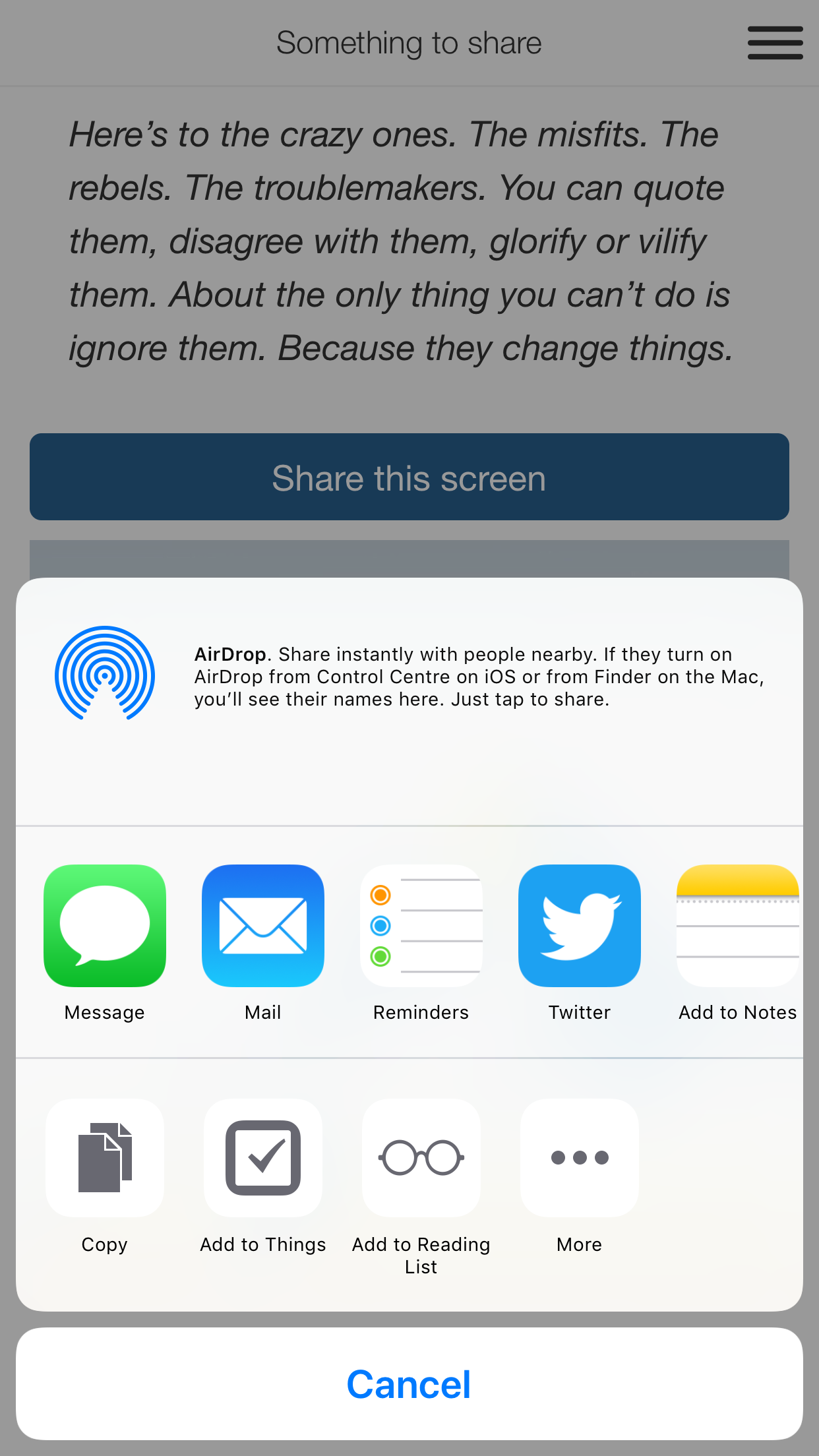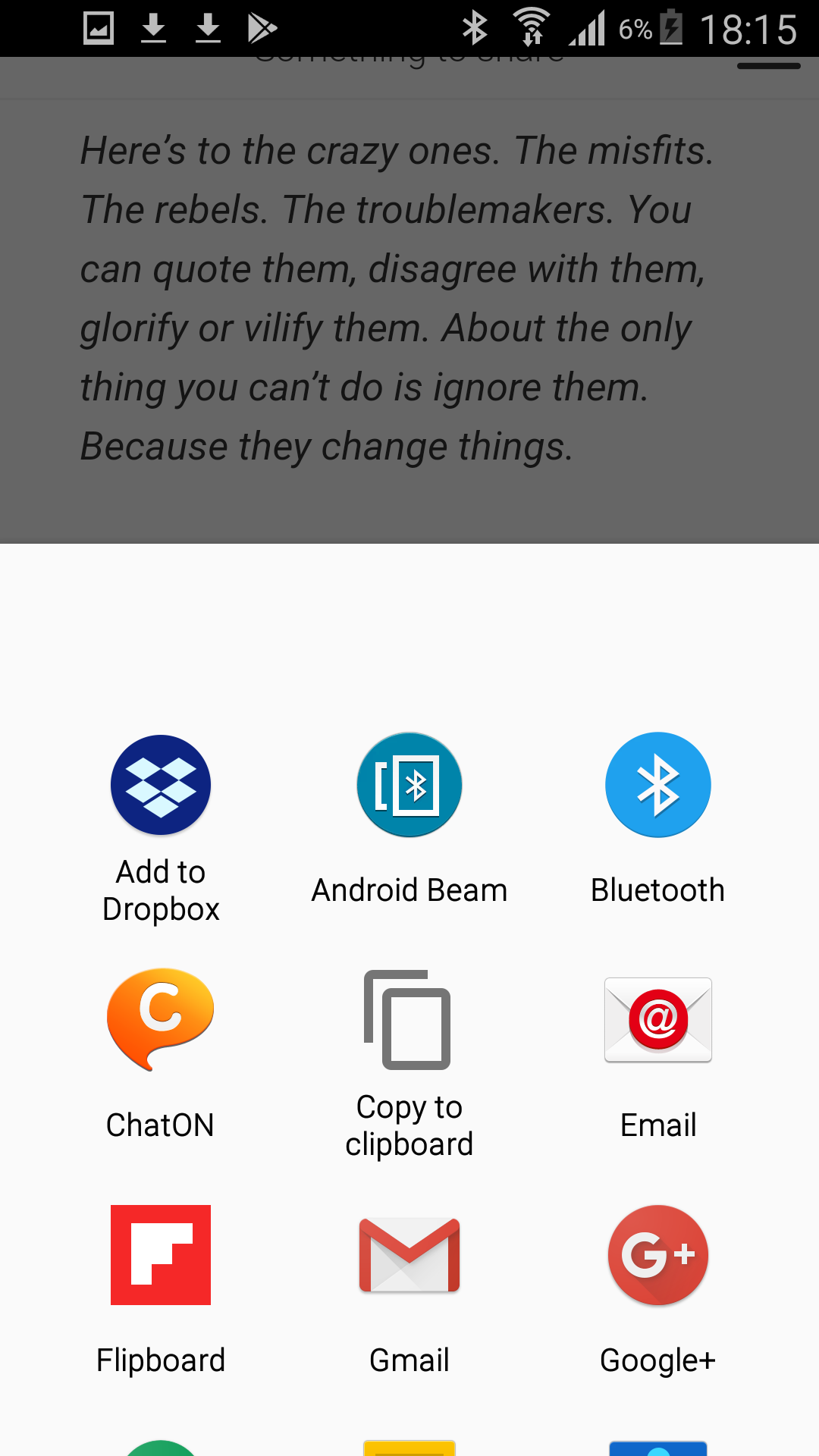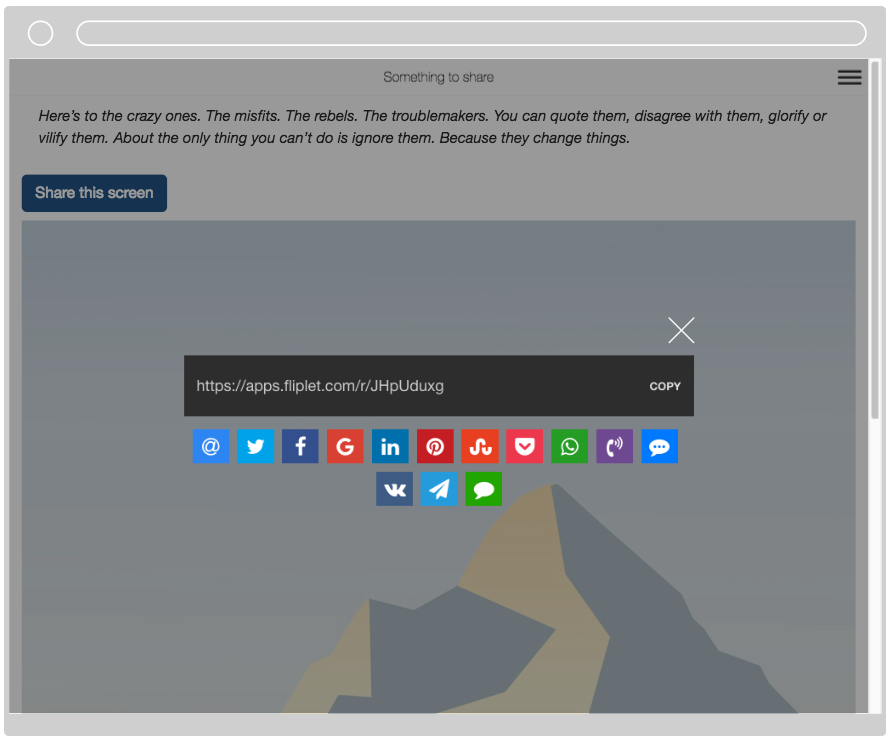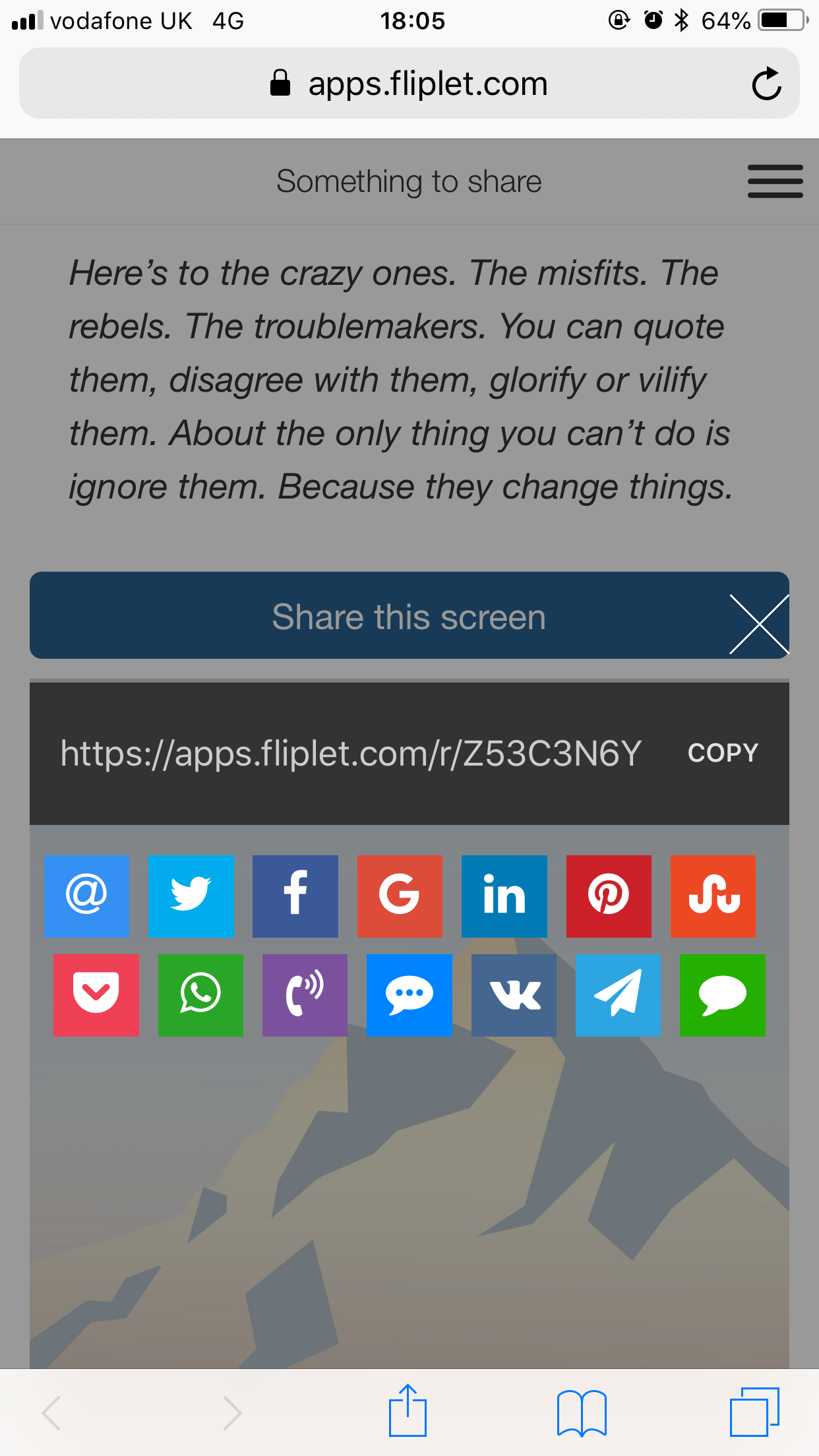Communicate JS APIs
The fliplet-communicate package contains the namespace Fliplet.Communicate and a set of helper methods for sending communications from the app.
.sendEmail()- Sends an HTML formatted email.batchSendEmail()- Sends batch of HTML formatted emails.composeEmail()- Composes an email on the device.sendSMS()- Sends an SMS message.batchSendSMS()- Sends batch of SMS messages.shareURL()- Share a URL.sendPushNotification()- Send push notifications
Send an email
Use our APIs to send an email to one or more recipients. Note that this feature is rate limited and improper use will result in your account being flagged for suspension.
Custom Email Domains: This API supports custom email domains. If you have configured a custom email domain for your organization, emails sent through this API will use your custom domain. To set up a custom email domain, see the Custom email domain guide.
Available options:
to: array of recipients for “to”, “cc” or “bcc”subject: subject of the emailfrom_name: the sender’s namehtml: HTML string for the email bodyheaders: “key:value” object with headers to add to the email (most headers are allowed). We recommend usingX-*prefixes to any custom header, e.g.X-My-Custom-Header: "value"attachments: array of attachments withtype(the MIME type),content(String or Buffer),name(the filename including extension) and optionalencoding(base64, hex, binary, etc)required: Set totrueto queue the request if the device is offline. When the device comes online, the queued requests will be sent. Default:false
var options = {
to: [
{ email: "john@example.org", name: "John", type: "to" },
{ email: "jane@example.org", name: "Jane", type: "cc" }
],
html: "<p>Some HTML content</p>",
subject: "My subject",
from_name: "Example Name",
headers: {
"Reply-To": "message.reply@example.com"
},
attachments: [
{
type: "text/plain",
name: "myfile.txt",
content: "Hello World"
},
{
type: "image/png",
name: "test.png",
encoding: 'base64',
// You can use our JS API to encode your content string to base64
content: Fliplet.Encode.base64("hello world")
}
]
};
// Returns a promise
Fliplet.Communicate.sendEmail(options);
You can also use {{ variables }} expressions in your options if you want the template to be compiled with other data:
var options = {
to: [ { email: "{{ emailTo }}", type: "to" } ],
html: "<p>Hi {{ userName }}</p>"
};
// This will compile any string template in your options
// with the input data passed as second parameter of the function.
Fliplet.Communicate.sendEmail(options, {
emailTo: 'john@example.com',
userName: 'John Doe'
});
Note: input options will get their value altered by the function as a result of the compilation process. If you want to preserve the input object original value, please make a copy as follows:
// Here we're using lodash "extend" method to make a copy of our options
// before they're sent to the "sendEmail" function.
Fliplet.Communicate.sendEmail(_.extend({}, options));
Send batch emails
Use our APIs to send batch of emails to one or more recipients. Note that this feature is rate limited and improper use will result in your account being flagged for suspension.
Custom Email Domains: This API supports custom email domains. If you have configured a custom email domain for your organization, emails sent through this API will use your custom domain. To set up a custom email domain, see the Custom email domain guide.
There will emails array of object with { options, data } template compilation.
var emails = [
{ options1, data1 },
{ options2, data2 },
{ optionN, dataN }
];
- options (Object) A map of options to pass to the function. The following properties found are supported:
- to (Array) array of recipients for “to”, “cc” or “bcc”
- subject (String) subject of the email
- html (String) HTML email body
- body (String) Plaintext email body. Note: If html and body are both set, html will be used.
- data (Array) An optional array of Base64 strings for the files to be attached. This only works on native devices. Each Base64 string should start with the format
data:%mimeType%;base64,, e.g.data:text/csv;base64,,data:image/png;base64,etc.
var emails = [{
options: {
to: [
{ email: 'john@example.org', name: 'John', type: 'to' },
{ email: 'jane@example.org', name: 'Jane', type: 'cc' }
],
html: '<p>Some HTML content</p>',
subject: 'My subject',
from_name: 'Example Name'
},
data: []
}, {
options: {
to: [
{ email: 'jack@example.org', name: 'Jack', type: 'to' },
{ email: 'jimmy@example.org', name: 'Jimmy', type: 'cc' }
],
html: '<p>Some HTML content</p>',
subject: 'My subject',
from_name: 'Example Name'
},
data: []
}];
// Returns a promise
Fliplet.Communicate.batchSendEmail(emails);
Compose an email
Compose an email on the device.
Fliplet.Communicate.composeEmail(options, data);
- options (Object) A map of options to pass to the function. The following properties found are supported:
- to (Array) array of recipients for “to”, “cc” or “bcc”
- subject (String) subject of the email
- html (String) HTML email body
- body (String) Plaintext email body. Note: If html and body are both set, html will be used.
- data (Array) An optional array of Base64 strings for the files to be attached. This only works on native devices. Each Base64 string should start with the format
data:%mimeType%;base64,, e.g.data:text/csv;base64,,data:image/png;base64,etc.
var options = {
to: [
{ email: "john@example.org", name: "John", type: "to" },
{ email: "jane@example.org", name: "Jane", type: "cc" }
],
html: "<p>Some HTML content</p>",
subject: "My subject"
};
// Returns a promise
Fliplet.Communicate.composeEmail(options);
Send an SMS
Default provider
var options = {
data: {
to: "+123456789",
body: "Hey!"
}
};
Fliplet.Communicate.sendSMS(options);
Optionally, add required: true in options to queue the request if the device is offline. When the device comes online, the queued requests will be sent.
Twilio
var options = {
provider: "twilio"
data: {
from: "+123456789"
to: "+123456789",
body: "Hey!"
},
options: {
twilio_sid: 'AC81caaa94b3b84bb7ba9c3cd96bcb152a', // Your Account SID from www.twilio.com/console
twilio_auth_token: 'AUTH_TOKEN'; // Your Auth Token from www.twilio.com/console
}
};
Fliplet.Communicate.sendSMS(options);
Let us know if you require to use another SMS provider and we’ll check whether we can integrate it on our system.
Send batch SMS
Send batch of SMS with sms array of object with {provider, data, options}.
Default
var sms = [{
data: {
to: "+123456789",
body: "Hey!"
}
},{
data: {
to: "+987654321",
body: "Hey!"
}
}];
Fliplet.Communicate.batchSendSMS(sms);
With Twilio provider
var sms = [{
provider: "twilio"
data: {
from: "+123456789"
to: "+123456789",
body: "Hey!"
},
options: {
twilio_sid: "AC81caaa94b3b84bb7ba9c3cd96bcb152a", // Your Account SID from www.twilio.com
twilio_auth_token: "AUTH_TOKEN" // Your Auth Token from www.twilio.com
}
},
{
provider: "twilio"
data: {
from: "+123456789"
to: "+987654321",
body: "Hey!"
},
options: {
twilio_sid: "AC81caaa94b3b84bb7ba9c3cd96bcb152a", // Your Account SID from www.twilio.com
twilio_auth_token: "AUTH_TOKEN" // Your Auth Token from www.twilio.com
}
}];
Fliplet.Communicate.batchSendSMS(sms);
Let us know if you require to use another SMS provider and we’ll check whether we can integrate it on our system.
Share a URL
Screenshots
Native apps
Native apps will use the operating systems’ built-in features to integrate with any other apps installed on the device.
| iOS | Android |
|---|---|
 |
 |
Web apps
Web apps will show users a URL to copy and provide icons to share the URL with popular servives.
| Desktop | Mobile |
|---|---|
 |
 |
Fliplet.Communicate.shareURL()
(Returns Promise)
Fliplet.Communicate.shareURL() lets users share a URL. The Promise is resolved when the action is completed or dismissed. The share options are passed to the resolving function, with an additional completed property to signify if an action was completed or cancelled.
// A simple way to share a URL
Fliplet.Communicate.shareURL('https://maps.google.com/?addr=EC2A+4DN');
// Add an optional message for apps that support the sharing a URL with a message
Fliplet.Communicate.shareURL({
url: 'https://maps.google.com/?addr=EC2A+4DN',
message: 'Drop by and say hi!'
});
Recommendation: Optionally provide a target to enure the share popover appears in the right place on iPads.
Fliplet.Communicate.shareURL({
url: 'https://maps.google.com/?addr=EC2A+4DN',
target: '#target'
});
jsSocials is used in web apps to let users share URLs using the following services:
- Email (
email) - LinkedIn (
linkedin) - Twitter (
twitter) - Facebook (
facebook)
Optionally provide an array of services in shares to use any of the services supported by jsSocials (see Example below).
Examples
Share a URL
Fliplet.Communicate.shareURL({
url: 'https://maps.google.com/?addr=EC2A+4DN',
shares: [
'email', 'twitter', 'facebook', 'googleplus', 'linkedin',
'pinterest', 'stumbleupon', 'pocket', 'whatsapp', 'viber',
'messenger', 'vkontakte', 'telegram', 'line'
]
});
Note: The following services only work on native devices if the app is installed.
- WhatsApp (
whatsapp) - Viber (
viber) - Facebook Messenger (
messenger) - Telegram (
telegram)
Share a page in a Fliplet app
See documentation for Fliplet.Content.
Send push notifications
(Returns Promise)
Available options:
title(required, the title of the notification)body(required, the message of the notification)sandbox(optional, whentrue, notifications are only sent to people using Fliplet Viewer. This is useful for testing.)subscription(optional, an array of push subscription IDs to target specific users. These IDs can be found in the “About this app” section of Fliplet apps, accessible via the top menu)badge(optional, sets the badge on iOS to a specific number)required: Set totrueto queue the request if the device is offline. When the device comes online, the queued requests will be sent. Default:false
Fliplet.Communicate.sendPushNotification(appId, {
title: 'Lorem ipsum',
body: 'Irure sed ad do dolor ad ut ut anim.'
});
Note: only app publishers and editors are allowed to send push notifications.